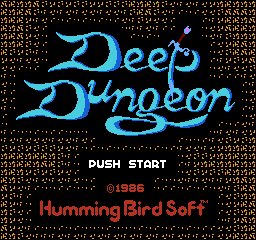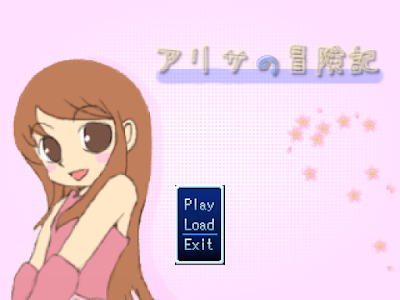Deep Dungeon Madou Senki: Actually quite shallow
Deep Dungeon Madou Senki / ディープダンジョン 魔洞戦記, HummingBirdSoft
1986, Famicom Disk System
I first came across Deep Dungeon as an article in OLD GAMERS HISTORY Vol. 3, a chronological treatment of early RPGs. It wasn't a particularly glowing review, and it was more focused on the period than on the game itself, but something struck me: as far as I could tell, it was the second turn-based RPG on console, after Dragon Quest, and the first DRPG on console, period. I decided to give it a shot—and, as its ultra-simple combat and lack of gimmicks turned out to hide a surprisingly enjoyable mapping experience, I finished it.
The dungeon is about the same size and depth as Wizardry's; its floors are 30x30 to the classic 20x20, but the thick walls really eat into that space. Unfortunately, all that empty space eats into my paper. C'est la vie; the more important thing is that the floors are, for the most part, open and geometrically interesting, unlike the disguised straight lines of most modern clones. Furthermore, unlike Wizardry, whose unique events petered out after the first few floors, Deep Dungeon keeps up a steady trickle of puzzles and NPCs until the end. You cannot simply skip from B5F to B10F, not when each floor has essential items and hints (you also literally cannot skip floors: there is unfortunately no elevator, though the ladder down is generally close to the ladder up). The game initially favors an arcade/apartment layout, with each floor divided into many small, accessible sub-areas; later floors mix it up just when it grows repetitive. My only gripe is that the long, featureless corridors are a pain to map (consider, for a moment, the tedium of counting off 22 squares in your head).
Luckily for the novice mapper, the game is quite gentle. Your facing is constantly displayed in the message log (c.f. Wizardry, where getting turned around is brutally possible); a purchaseable infinite-use compass displays your coordinates instead of a limited-cast spell; a later item offers an on-demand 2D map (I skipped this one); you can save anywhere (didn't use this either); spinners and chutes are absent, warps rare and obvious.
Less kind is the random encounter system, which works off of real time. Yes: while you're standing around double-checking your map, the game is ticking down toward the next fight. And don't be fooled into thinking START pauses the game, like I was: it actually just mutes the music. (SELECT pauses the game but hides the screen, so no cheating!) While strange and somewhat annoying, this could be taken as a concession to realism, an acknowledgement that mapping and exploring take time, not unlike the Basic/Expert D&D optional rule that allowed a party to travel at double speed through areas they had already mapped. And certainly, when you know where you're going, the effective per-square encounter rate is extraordinarily low, allowing you to get from A to B with few or no random encounters. (Deep Dungeons also has encounter-triggering squares, but they're rarer than Wizardry's encounter-triggering rooms.) More frustrating is how the game can trigger battles even while you read event text, such as clues written on the ground—if you prefer to write things down rather than screencap them, it can take multiple battles to copy one message. This, too, is realism (why wouldn't a monster pounce on a distracted adventurer?), but it's incredibly obnoxious.
The Ghoul Bear, preceded by the Man-Eating Bear and succeeded by the Night Bear.
The battle system is essentially a simplified one-on-one Wizardry, or alternatively Dragon Quest I with some Wizardry quirks, and it's nothing to write home about. You and the enemy trade blows until one of you dies; some enemies can poison you (agonizing in the early game when a single antidote costs several enemies' worth of gold) or cast spells; you yourself have no MP or spells per se, but you can use consumables (most importantly Bread, the only healing item) or reusable magic items. Battle magic items consume HP in exchange for spells which deal damage, inflict sleep or paralysis, etc.; they can be purchased from the store from the start of the game. This game's biggest quirk is the bafflingly high miss rate; maybe one round in three, the player and enemy will both miss each other, wasting several seconds of the player's time. (Miss rates are also high in early-game Wizardry, but that isn't such a problem when you have three or more attackers on each side.) Damage feels more random than in even Wizardry, with enemies hitting for 2 one round and 100 the next; keep your HP topped off! Bafflingly, magic attack items do more damage than physical attacks (even with the best sword in the game), miss much less, and only ever consume 1 HP, rendering the latter totally irrelevant except against bosses, who are immune to magic.
Deep Dungeon is a Famicom Disk System game, not a cartridge, and that implies some quirks. There are noticeable load times between floors (nothing egregious, but a bit funny for the period) and saving the game requires you to flip the disk, which must've been a bit stressful on hardware. On the bright side, each of the eight floors has its own background music, which helps differentiate them a bit (they otherwise just have different-colored walls)
Scattered throughout the dungeon are treasure chests, which contain gold, and trash heaps, which contain either a monster, treasure (gold), or just garbage (nothing). Both respawn whenever you leave the dungeon or change floors. You could beeline for the chests, but if you're grinding on B1F, the correct strategy is actually to beeline for the large "garbage dump" with 10+ trash heaps over the single chests. As the game goes on, enemy drops scale but garbage doesn't, so the hero isn't stuck dumpster diving for life. A second, even larger dump on B5F (which is quite close to a ladder—surely they knew) is the best gold-farming spot in the game, but at that point gold isn't very useful anyway.
As the game continues, you collect the Sword, Shield, and Armor of Roo, who has left helpful hints to their locations throughout the dungeon. Like in Wizardry II, you have to fight them first, but they aren't particularly tough. The annoying thing is that you start getting them right after you find a dungeon town on B3F with shops that sell strong equipment at a high price—I paid 800G for a Big Shield only to replace it with Roo's Shield half an hour later.
I was not pleased with the endgame. The top half of B7F, where you must find the captured princess and the Mark that will allow you to travel to Dark Lord Roo's lair, has some odiously repetitive geometry:
Hardly justifies the six-floor walkback, right? And then the final floor, reached by taking the Mark to an odd formation of pillars in the dungeon town, is even worse:
The final showdown with Roo is simple: after a classic GAME OVER Y/N dialogue choice, you trade hits until one of you dies. Hopefully you have the Princess's Dagger, which protects against magic, or it'll be you. Even if you do, it could very well still be you; it's all down to how many turns he wastes casting magic that doesn't work, how many of his attacks hit, and how many of those attacks do 150 damage instead of 15.
But on the whole, I enjoyed my time. I have to reiterate how basic the combat and overall gameplay is; if you don't enjoy mapping for its own sake, there's nothing here for you. If you do, and you're interested in this quirky little slice of DRPG history, give Deep Dungeon a look.
An English patch is available here.










Comments
Post a Comment